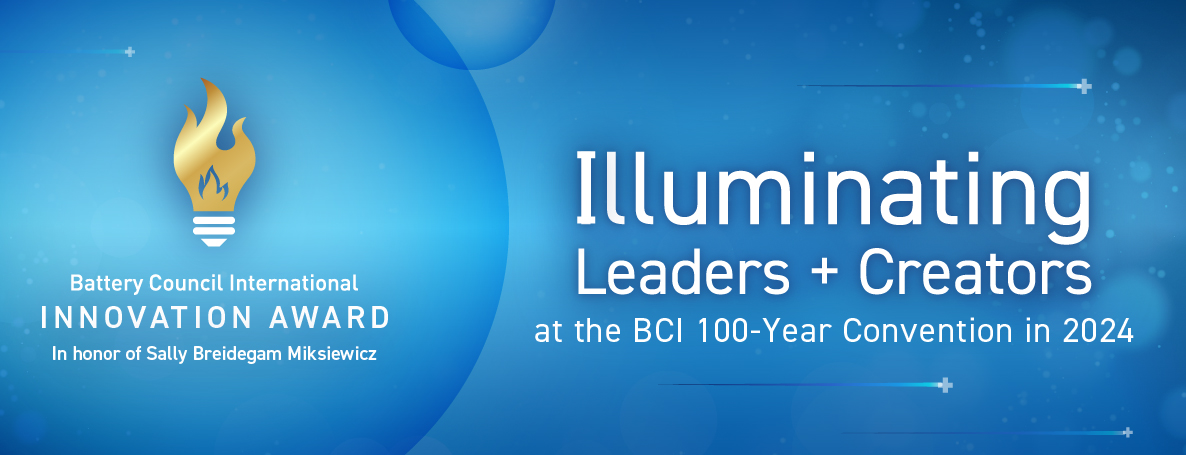The BCI Innovation Award in honor of Sally Breidegam Miksiewicz recognizes innovations within the battery industry that align with the guidelines of sustainability, safety, cost, performance, uniqueness and value.
Innovation Excellence Recognized
Every year, hundreds of innovations occur within the battery industry – from packaging and technology to equipment, chemistry and beyond. The goal of the BCI Innovation Award is to collect all of these innovations and showcase them to both the industry and the public.
The award was established to honor industry thought leader, Sally Breidegam Miksiewicz, former CEO of East Penn Manufacturing Co.
Congratulations to the 2024 Innovation Award Winner!

The award recognizes ENTEK’s solvent-free separator technology, providing a more environmentally friendly alternative that does not sacrifice strength or performance.
Most flooded lead acid batteries include polyethylene separators. The term “polyethylene separator” is a misnomer because these microporous separators require large amounts of precipitated silica to be sufficiently acid wettable. The volume fraction of precipitated silica and its distribution in the separator generally controls its electrical properties, while the volume fraction and orientation of polyethylene in the separator generally controls its mechanical properties. The porosity range for commercial polyethylene separators is generally 50-65%.
During the manufacture of polyethylene separators, precipitated silica is typically combined with a polyolefin, a process oil, and various minor ingredients to form a separator mixture that is extruded at elevated temperature through a sheet die to form an oil- filled sheet. The oil-filled sheet is calendered to its desired thickness and profile, and the majority of the process oil is extracted with an organic solvent. Hexane and trichloroethylene have been the two most common solvents used in separator manufacturing.
The solvent-laden sheet is then dried to form a microporous polyolefin separator and is slit into an appropriate width for a specific battery design.
In response to ongoing environmental pressures, government regulations, and health concerns related to organic solvents such as hexane and trichloroethylene, there is a need for a new approach to manufacture microporous membranes that can meet the performance and process requirements for production of a Pb-acid battery separator.
The submitted innovation involves the extrusion of isotactic-polypropylene (i-PP) in combination with a nucleating agent, silica, plasticizer, and surfactant to form a non-porous sheet that is wound into rolls. The extruded sheet is then stretched mono-axially or biaxially to form a microporous film as a result of cavitation and/or beta-crystal to alpha-crystal transformation. Next, ribs are extruded and bonded to the surface of the microporous sheet to form Pb-acid separators in roll form. Battery manufacturers can use this separator product within their existing capital equipment and manufacturing processes (e.g., enveloping).
Thank You to All the Companies Who Submitted for the 2024 Innovation Award
Receiving Honorable Mention recognition for their 2024 submissions were Clarios for its Clarios Smart AGM technology, and GS Yuasa Energy Solutions for its Advanced Lead-Nano carbon battery energy storage system.
Watch this video to see all submissions to this year’s BCI Innovation Award:
Submission Guidelines
The following guidelines should be considered when submitting an innovation. Entries do not need to align with all guidelines. Providing multiple supporting documents that align with these guidelines will give judges additional insight and clarity on your submission.
- Sustainability – How does your submission show environmental stewardship? Provide tangible aspirations, goals and objectives in helping to create a greener tomorrow.
- Safety – Does your submission show product and/or process stability? Can it be safely commercialized? Demonstrate a clear commitment to the safety of the general public and industry.
- Cost – Can the submission be easily commercialized and/or provide cost-optimized advantages? Is it an affordable alternative to existing technologies and processes?
- Performance – Show how your innovation meets its intended key objectives, goals and benefits.
- Uniqueness – How does it differ from existing products? Information should clearly define what makes this product, process and/or discovery unique.
- Value – How does the submission directly benefit the battery industry? Can the product be utilized outside of the company that created it?
It absolutely makes economic sense to create a sustainable product with a circular life cycle…



